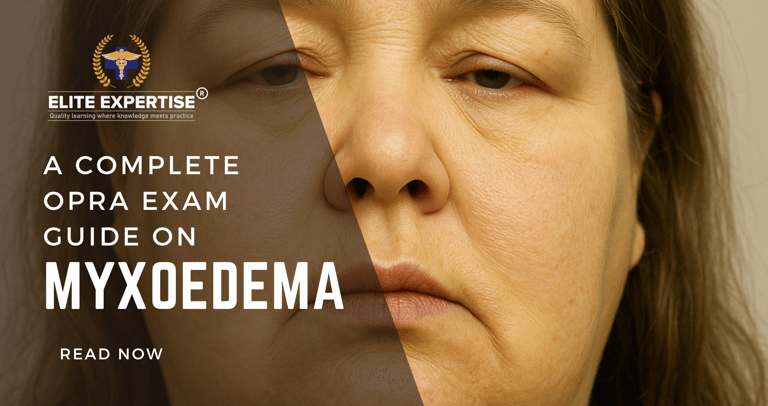ASK MY PHARMACIST | GOT QUESTIONS? Your pharmacist has answers. Click Here
A complete OPRA exam guide on Myxoedema with causes, symptoms, diagnosis, and treatment
What is myxoedema? Understand the causes, symptoms, diagnosis, and more for a detailed OPRA exam guide with key concepts, clinical significance, and pharmacist tips.
krupa
10/3/20252 min read


Key concepts:
Untreated hypothyroidism can cause severe skin and tissue swelling, known as myxoedema.
It is caused by the accumulation of mucopolysaccharides in the skin and soft tissues, causing swelling.
Symptoms include confusion to unconsciousness, slow heart rate, hypothermia, and sometimes respiratory failure.
It is commonly observed in middle-aged and older adults and is more prevalent in women.
If this condition is not treated, it can cause a life-threatening condition known as myxoedema coma.
Treatment involves thyroid hormone replacement, with intravenous levothyroxine.
A most severe and advanced stage of hypothyroidism is known as myxoedema. In this condition, there is insufficient production of thyroid hormones (T3 and T4). This condition results in a slowing of metabolism; if left untreated, it can cause multiple organ dysfunctions.
For OPRA exam aspirants, myxoedema is an essential topic, as it frequently appears in endocrinology, pharmacotherapy, and clinical case studies. This guide explains everything you need to know – from pathophysiology to treatment protocols – with a focus on what pharmacists should remember for clinical practice and exams.
Pathophysiology of Myxoedema
There will be a low deficiency of thyroid hormone (T3 and T4 levels), resulting in a decreased basal metabolic rate.
Metabolic slowing: This condition reduces oxygen consumption, heat production, and cold intolerance, leading to weight gain.
There will be a result of the accumulation of mucopolysaccharides. Water will be retained in the skin and subcutaneous tissues, eventually leading to non-pitting edema.
There are issues related to cardiovascular, neurological, GI, and dermatological problems.
From an OPRA aspirant perspective, candidates must note that the oedema is caused by non-pitting from other causes, such as nephrotic syndrome or heart failure.
Clinical features:
Diagnosis
Monitor the TSH levels in the blood. An elevated TSH level shows as a primary symptom of hypothyroidism, which leads to myxoedema (the most common cause).
Low levels of free T4 in blood confirm the diagnosis of myxoedema.
A positive result of Anti-TPO antibodies, which is seen in autoimmune hypothyroidism, known as Hashimoto’s
Additional tests, such as CBC (anaemia), lipid profile (hypercholesterolaemia), and ECG (bradycardia), can also be used.
Treatment & Management
1. Lifelong Thyroid Hormone Replacement
Levothyroxine (T4) – gold standard
Start with a low dose in elderly/cardiac patients and titrate every 6–8 weeks based on TSH levels.
2. Management of Myxoedema Coma (Medical Emergency)
IV levothyroxine or liothyronine
IV hydrocortisone (until adrenal insufficiency is ruled out)
Supportive care:
Gentle rewarming
IV fluids
Treat underlying cause (infection, trauma)
3. Monitoring
TSH is checked every 6–8 weeks until stable, then every 6–12 months.
Pharmacist’s Role: Educate patients about lifelong therapy, drug-food interactions (take on an empty stomach), and adherence to follow-up tests.
Conclusion
Myxoedema is a severe condition of untreated hypothyroidism. It shows advanced, severe hormone deficiency affecting multiple organ systems. Aspirants preparing for competitive exams like OPRA should pay attention to the key signs of these rare conditions, like non-pitting oedema, the hormone levels (high TSH, low T4), and how to manage emergencies. Early detection, lifelong levothyroxine therapy, and patient education can prevent complications such as myxedema coma and significantly improve outcomes.
At Elite Expertise, we comprehensively cover these rare yet critical conditions in our OPRA coaching. Our trainers, Mr Arief Mohammad and Mrs Harika Bheemavarpu, are accredited clinical consultants in Australia who bring real-life clinical experience into every virtual class. Their case-based teaching approach helps students understand not only the theory but also its practical, real-world application, ensuring they are exam-ready and confident in practising pharmacy in Australia.


About the Author
Krupa Karamchand
Content Writer | Elite Expertise
Krupa Karamchand is a B. Pharm graduate and KAPS-qualified pharmacist with over 7 years of experience in the pharmaceutical field. As an experienced SEO content writer, she combines her in-depth healthcare knowledge with proven digital strategies to create informative, engaging, and search engine–optimized blogs. Krupa is passionate about making complex medical topics easy to understand and accessible to all readers.
Follow On
Follow Us
+91 76750 84909
Privacy Policy | © 2025 Elite Expertise . All Rights Reserved.
ELITE EXPERTISE PTY. LTD (ABN: 15668292439) (ACN: 668292439)
Australian Statutory Education License: OPP 2025 ELITE EXPERTISE PTY. LTD
Disclaimer
Elite Expertise is an online education platform dedicated solely to providing coaching and preparation services for the OPRA, PEBC, PSI and PTE exams. We do not offer any sponsorship or migration services. All information provided on our platform is for educational purposes only and should not be interpreted as legal or immigration advice. For inquiries regarding sponsorship, visa applications, or migration services, please consult with licensed immigration professionals or relevant authorities.
Elite Expertise is a trusted and results-driven training platform specializing in preparation for international pharmacist licensing exams. Our comprehensive courses, expert instructors, and proven methodologies have helped countless pharmacy professionals achieve their goals and succeed in competitive regulatory exams. We are proud of our strong success rate and commitment to excellence.
Elite Expertise is an independent training provider. We are not affiliated with any global pharmacy regulatory authorities or official exam-conducting bodies.
Copyright © 2025 Elite Expertise. All rights reserved.
Address
Unit 1/73 Beverley St, Doncaster East VIC 3109, Australia
